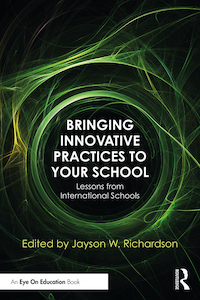Innovative Practices in International Schools
Bringing Innovative Practices to Your School: Lessons from International Schools
Edited by Jayson W. Richardson
(Routledge/Eye On Education, 2020 – Learn more)
Reviewed by Jane Swisher


Each chapter provides an overview of the category, includes the school leader’s description of the Implementation process in the context of an international school (hence a global perspective), and concludes with an adaptable takeaway from each experience.
What makes this book relevant and readable is that it goes beyond theory. We read about a school leader’s initiatives from the conception of the idea to its realization – the planning, the rollout, the challenges, the successes, and the results.
Richardson’s method of analyzing each practice and describing how international school leaders adapt, strategize and implement what is necessary to improve instruction is concise and comprehensible.
Looking beyond the surface
For example, in the equity category Natasha Haque and her team described the journey “in pursuit of international mindedness” in two international schools, one in Tanzania and another in the United Arab Emirates. Both schools assumed that they possessed an international perspective because they followed the IB curriculum, they had a diverse school community, and they promoted English as the global language.
However, a very different picture emerged when the team analyzed the actual practice. The curriculum focused uniquely on development related to Western economies. English was the preferred language with the singular focus of furthering a student’s access to global markets. The staff consisted mostly of expatriate teachers who were fluent in English and taught as they had learned.
In order to increase international mindedness, leaders started recruiting international and local staff, teachers rewrote curriculum to reflect global culture as well as local culture, and they tapped into the cultural and linguistic capital of their diverse student body.
I found this process relevant for any educational institution that includes the notion of equity in its vision statement. I can imagine that some school boards, administrators, and staff in American schools might unintentionally make decisions that align more with their own beliefs and those of their constituency rather than the value to be gained by exploring other perspectives. This story could be our story.
Other examples of innovation abound…
• How to change from solely assessing of content to assessing skills
• How to promote a learning mindset among all stakeholders
• How to recognize student and teacher agency in scheduling, in classroom design, on the playground
• How to empower teacher leaders and instructional coaches
Bringing Innovative Practices to Your School introduces and elaborates on many concepts at the forefront of educational discussion today, and it offers insights to new teachers as well as more experienced staff. I recommend that you add it to your professional library!
Jane Swisher is a national board certified Spanish teacher and the world language coordinator at Deer Path Middle School, District 67, in Lake Forest, Illinois. She has been teaching French, Spanish, and English for 40 years in many schools in the United States and overseas. She is an executive board member of the Illinois Council on the Teaching of Foreign Languages (ICTFL), an organization that promotes world language proficiency and interculturality.






























